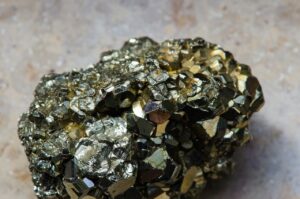Pyrite, commonly known as fool’s gold, is a mineral with the chemical formula FeS2. It is widely distributed in nature and has been used for centuries for various purposes, including in jewelry and as a source of sulfur. However, in recent years, there has been increasing interest in the potential of pyrite for sustainable mining practices and clean energy production.
Sustainable Mining Practices Traditional mining practices often involve large-scale excavation and processing methods that can have significant environmental impacts, such as habitat destruction, soil erosion, and water pollution. Sustainable mining practices aim to minimize these impacts by using techniques that are environmentally friendly and socially responsible.
One example of a sustainable mining practice is bioleaching, which uses microorganisms to extract metals from ores. This method is less harmful to the environment than traditional smelting techniques and can be used to extract metals from low-grade ores, including those containing pyrite.
Another sustainable practice is hydrometallurgy, which uses water-based solutions to extract metals from ores. This method can be more energy-efficient than traditional methods and can also reduce the use of harmful chemicals.

Pyrite as a Source of Sulfur Sulfur is an essential element in many industrial processes, including the production of sulfuric acid, which is used in the manufacture of fertilizers, chemicals, and metals. Pyrite is a major source of sulfur, and its sulfur content can be extracted through various processes, such as roasting or leaching.
The sulfuric acid produced from pyrite can be used in a variety of industries, including mining, agriculture, and chemical manufacturing. It is also used in the production of batteries and as a catalyst in the petroleum industry.
Energy Generation In addition to its use as a source of sulfur, pyrite can also be used as a source of energy. When pyrite is burned, it releases sulfur dioxide gas, which can be captured and converted into sulfuric acid. The heat generated from burning pyrite can also be used to produce steam, which can then be used to generate electricity.

This process, known as pyrite oxidation, has the potential to be a source of clean energy. Research is currently underway to develop more efficient methods of capturing and utilizing the energy produced from pyrite oxidation.
By-Products and Elements from Pyrite In addition to sulfur, pyrite mining and processing can yield other valuable by-products, such as gold, copper, and zinc. These by-products can be used in various industries, including electronics, construction, and jewelry making.
For example, gold and copper are valuable metals used in electronics and construction, while zinc is used in galvanizing steel and as a dietary supplement.
Environmental Impact and Mitigation While pyrite has many potential benefits, its mining and processing can also have significant environmental impacts. One of the main concerns is the generation of acid mine drainage, which occurs when sulfide minerals in the ore are exposed to air and water, producing sulfuric acid and releasing heavy metals into the environment.
To mitigate these impacts, it is essential to implement sustainable mining practices, such as proper waste management, reclamation of mining sites, and the use of advanced technologies to minimize environmental impact.
Future Potential As the world looks for more sustainable sources of energy, pyrite and its by-products could play an important role in the production of clean energy. For example, sulfuric acid produced from pyrite could be used in hydrogen fuel cells, which are a clean and efficient way to generate electricity.

Research and innovation in the field of pyrite mining and processing are essential to maximize its potential benefits while minimizing its environmental impact. Continued investment in sustainable mining practices and clean energy technologies will be key to realizing the full potential of pyrite for a sustainable future.
Conclusion Pyrite has the potential to be a valuable resource for sustainable mining practices and clean energy production. By using environmentally friendly mining techniques and maximizing the use of its by-products, we can reduce our reliance on traditional energy sources and move towards a more sustainable future. Continued research and innovation in this field will be essential to unlock the full potential of pyrite and its by-products for clean energy production.


Add your first comment to this post